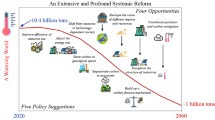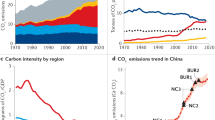Abstract
We examine the regional economic consequences of the Chinese central government’s proposal to limit China’s peak carbon emissions before 2030 and to achieve carbon neutrality by 2060. This is done in two stages. First, we draw on detailed simulations at the national level of the economic consequences of China’s net zero transition plan. These simulations are discussed in Chap. 13 herein (see Feng et al. in CHINAGEM-E: an energy and emissions extension of CHINAGEM—and its application in the context of carbon neutrality in China. Springer, 2023). Second, we develop a top-down regional model of the Chinese economy that distinguishes 31 regions. By inputting to this regional model the national results from the simulations reported in (Feng et al. in CHINAGEM-E: an energy and emissions extension of CHINAGEM—and its application in the context of carbon neutrality in China. Springer, 2023), we are able to trace the economic consequences of China’s net zero plan for 31 regions.
Access this chapter
Tax calculation will be finalised at checkout
Purchases are for personal use only
Similar content being viewed by others
Notes
- 1.
Equations (14.1)–(14.14) simplify the presentation of the top-down theory by describing margin demands as being exogenous. In the full theory, both as described in Dixon and Rimmer (2007), and as implemented in the model underpinning the simulations presented in this paper, margin demands are endogenous and linked to trade flows within and between regions. Readers interested in more details of the regional theory are referred to Dixon and Rimmer (2007).
- 2.
See Horridge et al. (2005) for a discussion of the TERM model and its parameterization.
- 3.
Global data on power plants are now downloadable at https://github.com/wri/global-power-plant-database.
References
Dixon PB, Rimmer MT, Tsigas ME (2007) Regionalising results from a detailed CGE model: macro, industry and state effects in the US of removing major tariffs and quotas. Pap Reg Sci 86:31–55
Feng S, Peng X, Adams P (2023) CHINAGEM-E: an energy and emissions extension of CHINAGEM—and its application in the context of carbon neutrality in China. In: Peng (ed) CHINAGEM—a dynamic general equilibrium model of China: theory, data and applications. Chapter 13. Springer
Horridge JM (2012) The TERM model and its database. In: Wittwer G (ed) Economic modeling of water, the Australian CGE experience. Chapter 2. Springer, Dordrecht, Netherlands
Horridge JM, Madden JR, Wittwer G (2005) The impact of the 2002–03 drought on Australia. J Policy Modeling 27:285–308
Leung R (2018) With little explanation, ‘U’ abruptly cuts ties with China Data Center. Michigan Daily, Oct 3. www.michigandaily.com/section/research/little-explanation-u-m-abruptly-cuts-ties-china-data-center
Wittwer G, Horridge JM (2018) Prefectural representation of the regions of China in a bottom-up CGE model: SinoTERM365. J Glob Econ Anal 3(2):178–213. https://doi.org/10.21642/JGEA.030204AF
Author information
Authors and Affiliations
Corresponding author
Editor information
Editors and Affiliations
Appendices
Appendix 1: Core Equations, Variables, Coefficients and Parameters of the Regional Model
1.1 Equations
1.2 Set Definitions
- IND::
-
{j1 – j159} Set of all industries.
- REG::
-
{r1 – r31} Set of all regions.
- SRC::
-
{s1 – s2} Sources of commodities: s1 (domestic) and s2 (foreign).
- COM::
-
{c1 – c157} Set of all commodities.
1.3 Variables
Variable | Closure | Set range | Description |
|---|---|---|---|
\(demCSR_{i,s,r}\) | endog | \(i \in {\text{COM}}\) \(s \in {\text{SRC}}\) \(r \in {\text{REG}}\) | Percentage change in demand for commodity i, s within region r |
\(empr_{r}\) | endog | \(r \in {\text{REG}}\) | Percentage change in regional employment |
\(emp^{(C)}\) | exog | Percentage change in national employment. Input from CHINAGEM | |
\(grpfc_{r}\) | endog | \(r \in {\text{REG}}\) | Percentage change in real gross regional product (at factor cost) for region r |
\(grpmp_{r}\) | endog | \(r \in {\text{REG}}\) | Percentage change in real gross regional product (at market prices) for region r |
\(gdpreal^{(C)}\) | exog | Percentage change in real GDP (at market prices). Input from CHINAGEM | |
\(labind_{j}^{(C)}\) | exog | \(j \in {\text{IND}}\) | Percentage change in national employment in industry j. Input from CHINAGEM |
\(reg4_{i,r}\) | exog | \(i \in {\text{COM}}\) \(r \in {\text{REG}}\) | Percentage change in share of exports of i leaving China from region r |
\(reg5_{i,s,r}\) | exog | \(i \in {\text{COM}}\) \(s \in {\text{SRC}}\) \(r \in {\text{REG}}\) | Percentage change in share of economy-wide public consumption demands for i, s accounted for by government demand in region d |
\(relemp_{r}\) | endog | \(r \in {\text{REG}}\) | Used for calculating the deviation in region r’s employment from national employment |
\(x0CSR_{i,s,r}\) | endog | \(i \in {\text{COM}}\) \(s \in {\text{SRC}}\) \(r \in {\text{REG}}\) | Percentage change in supply of commodity i, s from region r |
\(x1r_{i,s,j,r}^{{}}\) | endog | \(i \in {\text{COM}}\) \(s \in {\text{SRC}}\) \(j \in {\text{IND}}\) \(r \in {\text{REG}}\) | Percentage change in demand for good i from source s by industry j in region d for input to current production |
\(x1csi_{i,s,j}^{(C)}\) | exog | \(i \in {\text{COM}}\) \(s \in {\text{SRC}}\) \(j \in {\text{IND}}\) | Percentage change in demand for commodity i from source s by industry j for input to current production. Input from CHINAGEM |
\(x2r_{i,s,j,r}^{{}}\) | endog | \(i \in {\text{COM}}\) \(s \in {\text{SRC}}\) \(j \in {\text{IND}}\) \(r \in {\text{REG}}\) | Percentage change in demand for good i from source s by industry j in region r for input to capital formation |
\(x2csi_{i,s,j}^{(C)}\) | exog | \(i \in {\text{COM}}\) \(s \in {\text{SRC}}\) \(j \in {\text{IND}}\) | Percentage change in demand for commodity i from source s by industry j for input to capital formation. Input from CHINAGEM |
\(x3r_{i,s,r}\) | endog | \(i \in {\text{COM}}\) \(s \in {\text{SRC}}\) \(r \in {\text{REG}}\) | Percentage change in demand for commodity i, s by households in region r |
\(x3_{i,s}^{(C)}\) | exog | \(i \in {\text{COM}}\) \(s \in {\text{SRC}}\) | Percentage change in household demand for source-specific commodity i, s. Input from CHINAGEM |
\(x4r_{i,r}\) | endog | \(i \in {\text{COM}}\) \(r \in {\text{REG}}\) | Percentage change in demand for exports of i via a port in region r |
\(x4_{i}^{(C)}\) | exog | \(i \in {\text{COM}}\) | Percentage change in national exports of commodity i. Input from CHINAGEM |
\(x5r_{i,s,r}\) | endog | \(i \in {\text{COM}}\) \(s \in {\text{SRC}}\) \(r \in {\text{REG}}\) | Percentage change in demand for commodity (i, s) by government in region r |
\(x5_{i,s}^{(C)}\) | exog | \(i \in {\text{COM}}\) \(s \in {\text{SRC}}\) | Percentage change in government demands for i, s at the national level. Input from CHINAGEM |
\(\Delta {\text{X6R}}_{i,s,r}\) | endog | \(i \in {\text{COM}}\) \(s \in {\text{SRC}}\) \(r \in {\text{REG}}\) | Change in demand for (i, s) for addition to inventories in region r |
\(\Delta {\text{X6}}_{{\text{i,s}}}^{{\text{(C)}}}\) | exog | \(i \in {\text{COM}}\) \(s \in {\text{SRC}}\) | Change in national demand for commodity i from source s for addition to stocks. Input from CHINAGEM |
\(xmar_{i,r}\) | exoga | \(i \in {\text{COM}}\) \(r \in {\text{REG}}\) | Percentage change in demand for commodity i for use as a margin service to facilitate commodity flows to/within region r |
\(\, y_{{}}^{(C)}\) | exog | Percentage change in national household disposable income. Input from CHINAGEM | |
\(yr_{r}\) | endog | \(r \in {\text{REG}}\) | Percentage change in regional household disposable income |
\(z_{j}^{(C)}\) | exog | \(j \in {\text{IND}}\) | Percentage change in activity level of industry j. Input from CHINAGEM |
\(z_{j,r}\) | endog | \(j \in {\text{IND}}\) \(r \in {\text{REG}}\) | Percentage change in output of regional industry j, r |
1.4 Coefficients and Parameters
See Table 14.3.
Rights and permissions
Copyright information
© 2023 Springer Nature Singapore Pte Ltd.
About this chapter
Cite this chapter
Giesecke, J., Peng, X., Wittwer, G. (2023). Regional Extension and Its Application—The Regional Economic Implications of Carbon Neutrality in China. In: Peng, X. (eds) CHINAGEM—A Dynamic General Equilibrium Model of China: Theory, Data and Applications. Advances in Applied General Equilibrium Modeling. Springer, Singapore. https://doi.org/10.1007/978-981-99-1850-8_14
Download citation
DOI: https://doi.org/10.1007/978-981-99-1850-8_14
Published:
Publisher Name: Springer, Singapore
Print ISBN: 978-981-99-1849-2
Online ISBN: 978-981-99-1850-8
eBook Packages: Economics and FinanceEconomics and Finance (R0)




